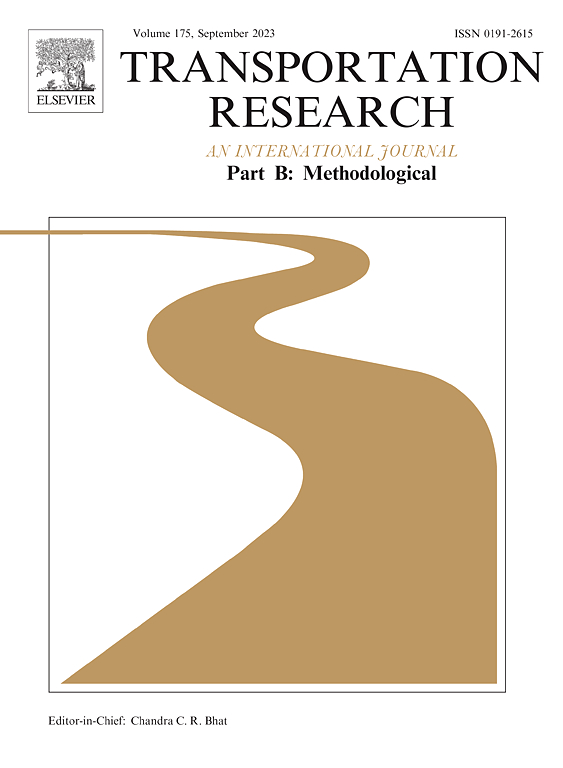Airport charge, terminal capacity, and suggested airport arrival time: Considering non-aeronautical business
IF 6.3
1区 工程技术
Q1 ECONOMICS
引用次数: 0
Abstract
This study investigates the optimal decisions of airports regarding charges, capacity, and passengers’ suggested arrival time at the airport (before flight departures) under different objectives (maximizing airport profit or social welfare). Our model incorporates an airport, airlines with market power, and passengers, and examines the impact on concession revenue of dwell time in (terminal) retail zones and queuing time in check-in zones. We find that whether a profit-maximizing airport charges or subsidizes airlines for using its aeronautical service depends critically on whether the trip demand is elastic with respect to airport charge and whether trip demand increases the concession surplus. In particular, when this is elastic and the trip demand also raises concession revenue, the airport will subsidize airlines. For welfare-maximizing airports, when trip demand decreases the concession surplus (due to shopping time shrinkage), airports would set the charge that the ticket price paid by passengers is higher than the social marginal cost incurred. Further, the airport’s decisions regarding terminal capacity are influenced by the trade-off between the revenue gained from increased traffic and the revenue lost from the reduced dwell time. By comparison with a welfare-maximizing airport, a profit-maximizing airport tends to invest more in terminal capacity under lower traffic, but less under higher traffic: basically, the effect of expanding terminal capacity on increasing shopping time (dwell time in the retail zone) is more pronounced for lower traffic, and the effect diminishes for higher traffic. The study also shows that a profit-maximizing airport would suggest travelers arrive at the airport earlier than a welfare-maximizing airport, so as to increase the non-aeronautical revenue.
机场收费,航站楼容量,建议机场到达时间:考虑非航空业务
本研究探讨机场在不同目标(机场利润最大化或社会福利最大化)下,对收费、运力和旅客建议到达机场时间(航班出发前)的最优决策。我们的模型结合了机场、具有市场支配力的航空公司和乘客,并检验了(航站楼)零售区停留时间和值机区排队时间对特许收入的影响。我们发现,利润最大化的机场是对航空公司收费还是补贴,关键取决于出行需求相对于机场收费是否具有弹性,以及出行需求是否会增加特许权盈余。特别是,当这是弹性的,旅行需求也增加特许权收入时,机场将补贴航空公司。对于福利最大化的机场,当出行需求减少特许剩余(由于购物时间缩减)时,机场将设定旅客支付的票价高于所产生的社会边际成本的收费。此外,机场关于航站楼容量的决策受到流量增加带来的收入和停留时间减少带来的收入损失之间的权衡的影响。与福利最大化的机场相比,利润最大化的机场在客流量较低时对航站楼容量的投入较多,而在客流量较高时则较少:基本上,客流量较低时,扩大航站楼容量对增加购物时间(零售区停留时间)的影响更为明显,客流量较高时,这种影响减弱。研究还表明,利润最大化的机场会使旅客比福利最大化的机场更早到达机场,从而增加非航空收入。
本文章由计算机程序翻译,如有差异,请以英文原文为准。
求助全文
约1分钟内获得全文
求助全文
来源期刊
CiteScore
12.40
自引率
8.80%
发文量
143
审稿时长
14.1 weeks
期刊介绍:
Transportation Research: Part B publishes papers on all methodological aspects of the subject, particularly those that require mathematical analysis. The general theme of the journal is the development and solution of problems that are adequately motivated to deal with important aspects of the design and/or analysis of transportation systems. Areas covered include: traffic flow; design and analysis of transportation networks; control and scheduling; optimization; queuing theory; logistics; supply chains; development and application of statistical, econometric and mathematical models to address transportation problems; cost models; pricing and/or investment; traveler or shipper behavior; cost-benefit methodologies.

 求助内容:
求助内容: 应助结果提醒方式:
应助结果提醒方式:


